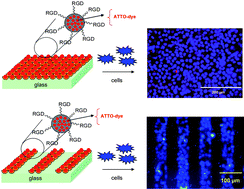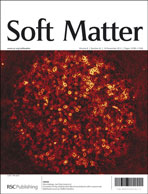Self-assembled monolayers of bifunctional periodic mesoporous organosilicas for cell adhesion and cellular patterning†
Abstract
Periodic mesoporous organosilicas (PMOs), an important class of inorganic–organic functional hybrid materials, find numerous potential applications in nano- and biotechnologies due to their porous nature, large surface area (internal and external surfaces) and the structural diversity of their organosilica frameworks. In this contribution we report on the selective functionalization of both the internal and the external surfaces of PMOs with a fluorescent dye and bioactive molecules, respectively. Subsequently we used these unique bifunctionalized PMO nanoparticles for the preparation of non-patterned and patterned self-assembled monolayers (SAMs) on glass. In cell experiments we showed that these new biomaterial surfaces enhance cell adhesion. We were able to determine the position of the inside dye substituted PMOs of the biomolecule functionalized surface in relation to the position of the stained cells by fluorescence microscopy as well. Patterned SAMs of bifunctionalized PMOs lead to selective cellular patterning along the stripes (texture of the surface).


 Please wait while we load your content...
Please wait while we load your content...